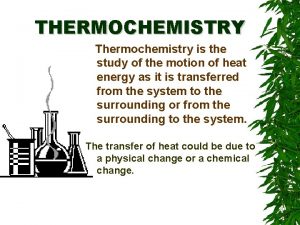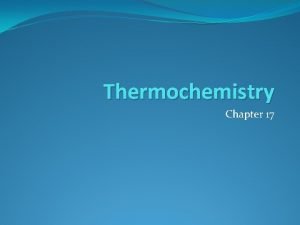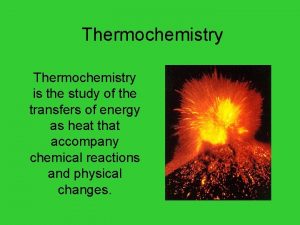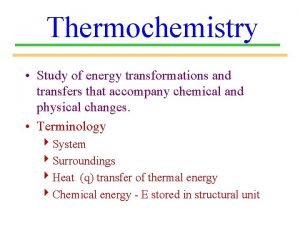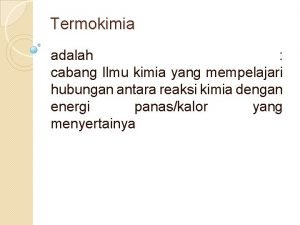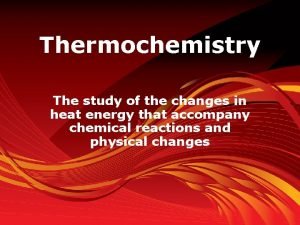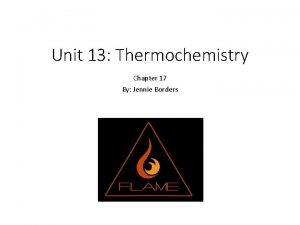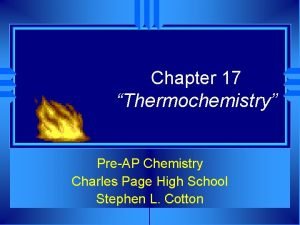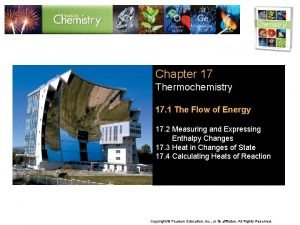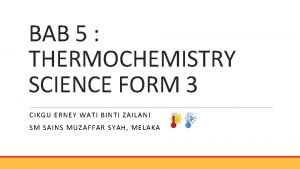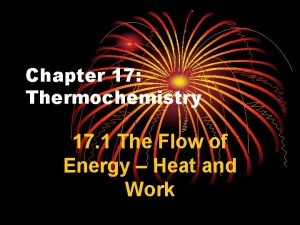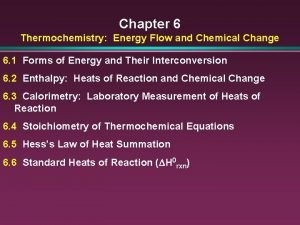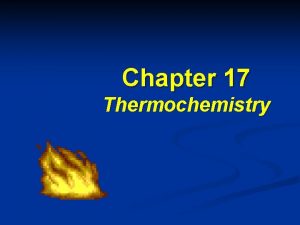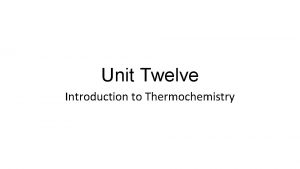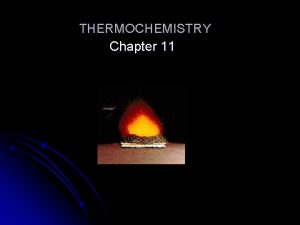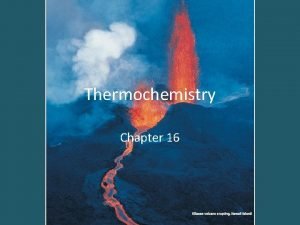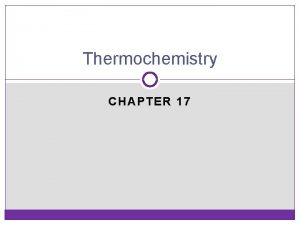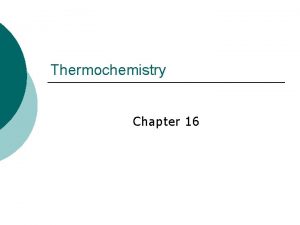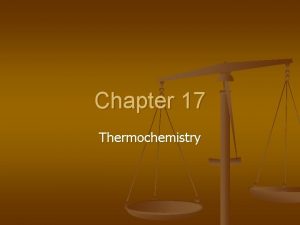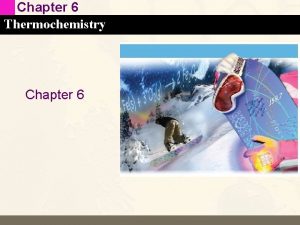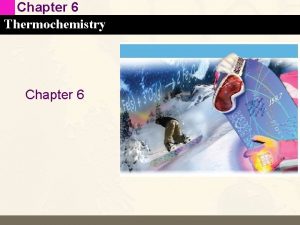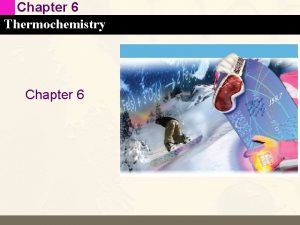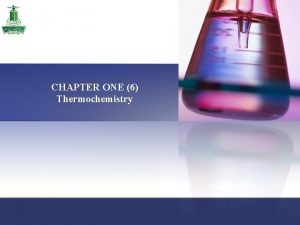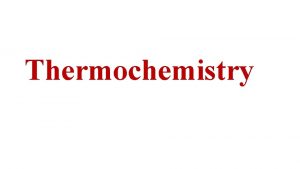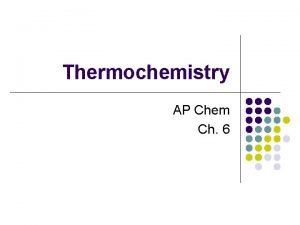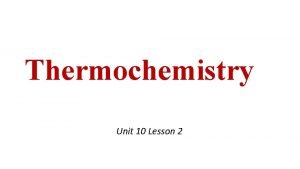Thermochemistry Chapter 17 Thermochemistry is the study of























- Slides: 23

Thermochemistry Chapter 17

Thermochemistry is the study of energy changes that occur during chemical reactions and changes in state. The energy stored in the chemical bonds of a substance is called chemical potential energy.

Thermochemistry Heat (q) energy that transfers from one object to another because of a difference in temperature Temperature measure of average kinetic energy of particles Heat flows from a warmer object to a cooler object

Exothermic and Endothermic Exothermic Process Releases heat to surroundings Endothermic Process Absorbs heat from surroundings What happens in endothermic and exothermic processes? • In an endothermic process, the system gains heat as the surroundings cool down. • In an exothermic process, the system loses heat as the surroundings heat up.

l Is the following picture an example of an endothermic or exothermic reaction?

l Is the following picture an example of an endothermic or exothermic reaction?

Measuring Heat Flow Heat flow is measured in two common units, the calorie and the joule. The energy in food is usually expressed in Calories.

Heat Capacity The heat capacity of an object depends on both its mass and its chemical composition. The amount of heat needed to increase the temperature of an object exactly 1°C is the heat capacity of that object.

Specific Heat The specific heat capacity, or simply the specific heat, of a substance is the amount of heat it takes to raise the temperature of 1 g of the substance 1°C.

l Because it is mostly water, the filling of a hot apple pie is much more likely to burn your tongue than the crust.

Specific Heat Problem The temperature of a 95. 4 g piece of copper increases from 25. 0 o. C to 48. 0 o. C when the copper absorbs 849 J of heat. What is the specific heat of copper?

Specific Heat Problem How much heat is required to raise the temperature of 250. 0 g of mercury 520 C?

Enthalpy l Enthalpy (H) = heat content of a system at constant pressure l q = ΔH * m

Heat of Fusion & Solidification l heat of fusion (∆Hfus) = heat absorbed by one mole of a solid as it melts at a constant temperature l heat of solidification (∆Hsolid )= heat lost when one mole of a liquid solidifies at constant temperature

Enthalpy changes accompany changes in state. The quantity of heat absorbed by a melting solid is exactly the same as the quantity of heat released when the liquid solidifies; that is, ∆Hfus = –∆Hsolid.

Enthalpy and changes in state This table will be given for all enthalpy and changes in state problems.

Practice l How many grams of ice at 0 o. C will melt if 2. 25 k. J of heat are added?

Practice l How many kilojoules of heat are required to melt a 10. 0 g popsicle at 0 o. C? Assume the popsicle has the same molar mass and heat of fusion as water.

Heat of Vaporization & Condensation lheat of vaporization (∆Hvap) = heat necessary to vaporize 1 mole of a liquid lheat of condensation (∆Hcond) = heat released when 1 mol of vapor condenses at the normal boiling point

Enthalpy and changes in state The quantity of heat absorbed by a vaporizing liquid is exactly the same as the quantity of heat released when the vapor condenses; that is, ∆Hvap = – ∆Hcond.

Practice l How much heat (in k. J) is absorbed when 24. 8 g of H 2 O (l) at 100 o. C and 101. 3 k. Pa is converted to steam at 100 o. C?

Practice l How many kilojoules of heat are absorbed when 0. 46 g of chloroethane (C 2 H 5 Cl, bp. 12. 3 o. C) vaporizes at its normal boiling point? The heat of vaporization of chloroethane is 26. 4 k. J/mol.

Review Question ¡Assuming that two samples of different materials have equal mass, the one that becomes hotter from a given amount of heat is the one that lhas the higher specific heat capacity. lhas the higher molecular mass. lhas the lower specific heat capacity. lhas the higher density.
 Thermochemistry is the study of *
Thermochemistry is the study of * Thermochemistry is the study of...
Thermochemistry is the study of... Thermochemistry is a study of
Thermochemistry is a study of Thermochemistry is the study of *
Thermochemistry is the study of * Study of energy transformations
Study of energy transformations Termokimia adalah cabang ilmu kimia yang mempelajarai ... *
Termokimia adalah cabang ilmu kimia yang mempelajarai ... * Thermochemistry is study of
Thermochemistry is study of Thermochemistry
Thermochemistry Chapter 17 thermochemistry practice problems answers
Chapter 17 thermochemistry practice problems answers Chapter 17 thermochemistry
Chapter 17 thermochemistry Chapter 17 thermochemistry answer key
Chapter 17 thermochemistry answer key Thermochemistry notes form 3
Thermochemistry notes form 3 Chapter 17 thermochemistry
Chapter 17 thermochemistry Chapter 6 thermochemistry
Chapter 6 thermochemistry Chapter 17 thermochemistry
Chapter 17 thermochemistry Hình ảnh bộ gõ cơ thể búng tay
Hình ảnh bộ gõ cơ thể búng tay Lp html
Lp html Bổ thể
Bổ thể Tỉ lệ cơ thể trẻ em
Tỉ lệ cơ thể trẻ em Gấu đi như thế nào
Gấu đi như thế nào Thang điểm glasgow
Thang điểm glasgow Chúa yêu trần thế alleluia
Chúa yêu trần thế alleluia Môn thể thao bắt đầu bằng từ đua
Môn thể thao bắt đầu bằng từ đua Thế nào là hệ số cao nhất
Thế nào là hệ số cao nhất

